Czichos H., Saito T., Smith L.E. (Eds.) Handbook of Metrology and Testing
Подождите немного. Документ загружается.

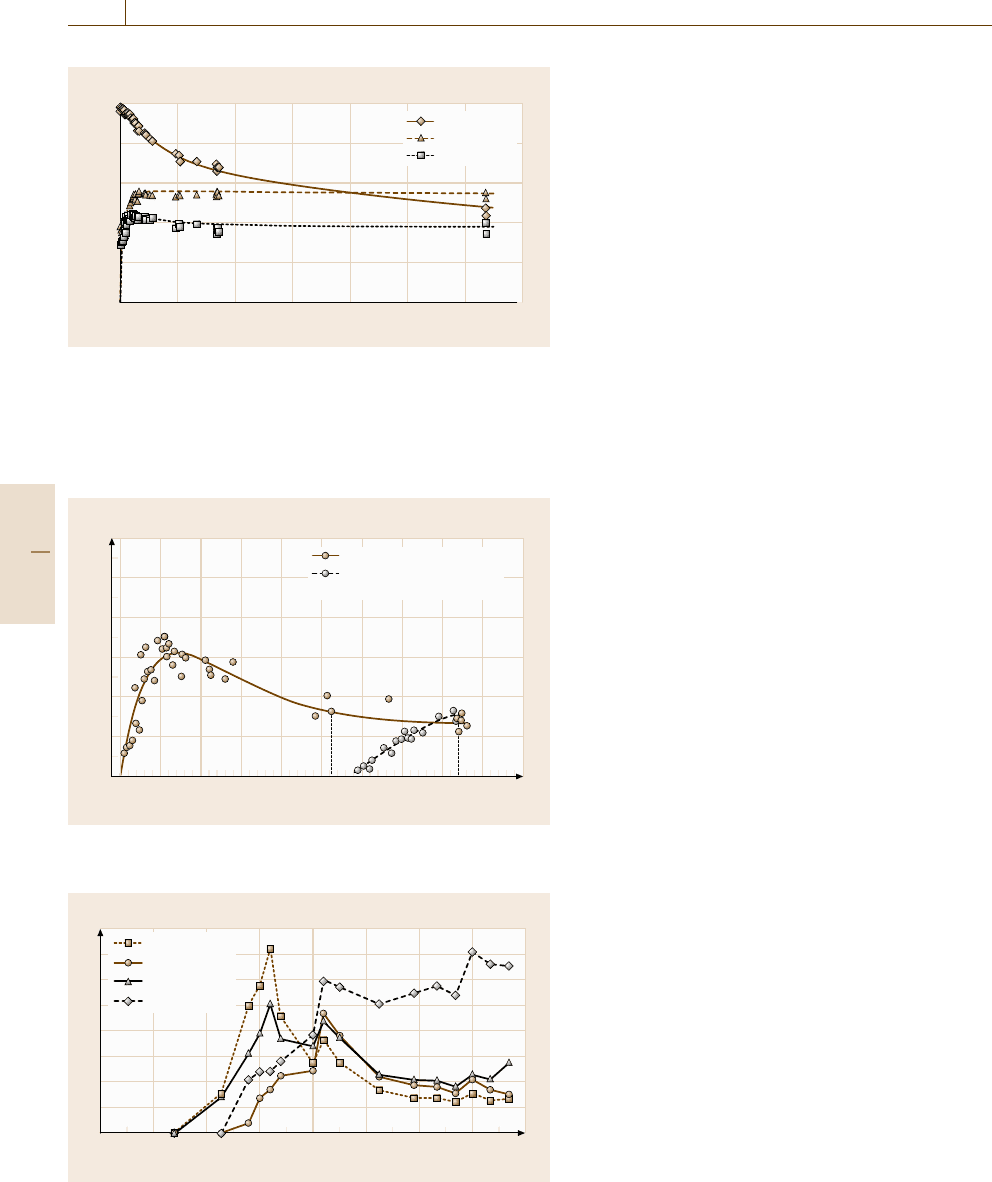
868 Part D Materials Performance Testing
100
10
1
0.1
0.01
0.001
0 500 1000 1500 2000 2500 3000 3500
Time (d)
Dichlofluanid
Tebuconazole
Permethrine
SERa (µg/m
2
h)
Fig. 15.26 Area specific emission rate (SER
a
) for the three biocides
dichlofluanid, tebuconazole and permethrine. For the increase at the
beginning the SER
a
has to be regarded as apparent specific emission
rate due to adsorption (sink effects) on the chamber surfaces that
result in reduced concentrations in air. The experiment was started
in 1994 and is still running
Concentration (µg/m
3
)
0.06
0.05
0.04
0.03
0.02
0.01
0
0 100 200 300 400 500 600 700 800 900 1000
Testing time (d)
Permethrine
2nd chamber (empty) in line
at t = 526d
Fig. 15.27 Empty chamber connected to the test chamber: perme-
thrine (after [15.105])
Concentration (µg/m
3
)
40
35
30
25
20
15
10
5
0
0 20 40 60 80 100 120 140 160
Testing time (d)
Hexanal
Hexanoic acid
Heptanal
Heptanoic acid
seen for example in Fig. 15.24 for terpene emissions
from a particleboard. The terpene emissions result from
the pine wood used for the production of the particle-
board.
For SVOC emissions the decrease over time is nor-
mally not as strong as they have lower vapor pressures
and therefore depletion of the boundary layer of the ma-
terial takes longer. Furthermore they can show a longer
increase at the beginning of the test due to adsorption
effects (Fig.15.25).
For extremely-low-volatility SVOC – often called
POMs(Table15.6) – a distinct emission behavior can
generally be observed. For these substances increasing
concentrations over weeks and months can be observed
asshowninFig.15.26 for some biocides [15.101].
The time to reach the maximum concentration
was about 125 d for tebuconazole and permethrine.
After reaching its maximum, the concentration re-
mained almost constant over time for nearly ten years
(tebuconazole) or showed only a slight decrease (per-
methrine).
Generally it should be stated, that organic sub-
stances with extremely low vapor pressure show
a tendency to adsorb strongly on surfaces. One result
of this is that SVOC/POM are retained by the mater-
ial itself and thus possibly only show slow migration
to the surface of the material, slow desorption from
materials surface and therefore delayed emissions. An-
other reason for slowly increasing concentrations is
the adsorption of emitted low-volatility organic sub-
stances on inner surfaces of the emission test chamber
(chamber walls): so called sink effects. Figure 15.27
illustrates this behavior for the example of a biocide
(permethrin) where a second chamber was switched
in line to a first chamber that was already in equi-
librium [15.105]. As can be seen it took about 250 d
until the second chamber was also in equilibrium.
Relevant amounts of biocide where adsorbed on cham-
ber walls that acted as sinks. This could be shown
by elution of the chamber walls after the end of the
test. Knowing the amount of substance transported
out of the chamber by air flow together with the
amount of substance adsorbed on chamber walls gener-
ally allows, even for this very-low-volatility substance,
one to calculate emission rates after a shorter testing
time.
Fig. 15.28 Secondary emissions from a flooring adhesive
(solid line with boxes: hexanal, dashed line with boxes:
hexanoic acid, solid line with circles: heptanal, dashed line
with circles: heptanoic acid)
Part D 15.2
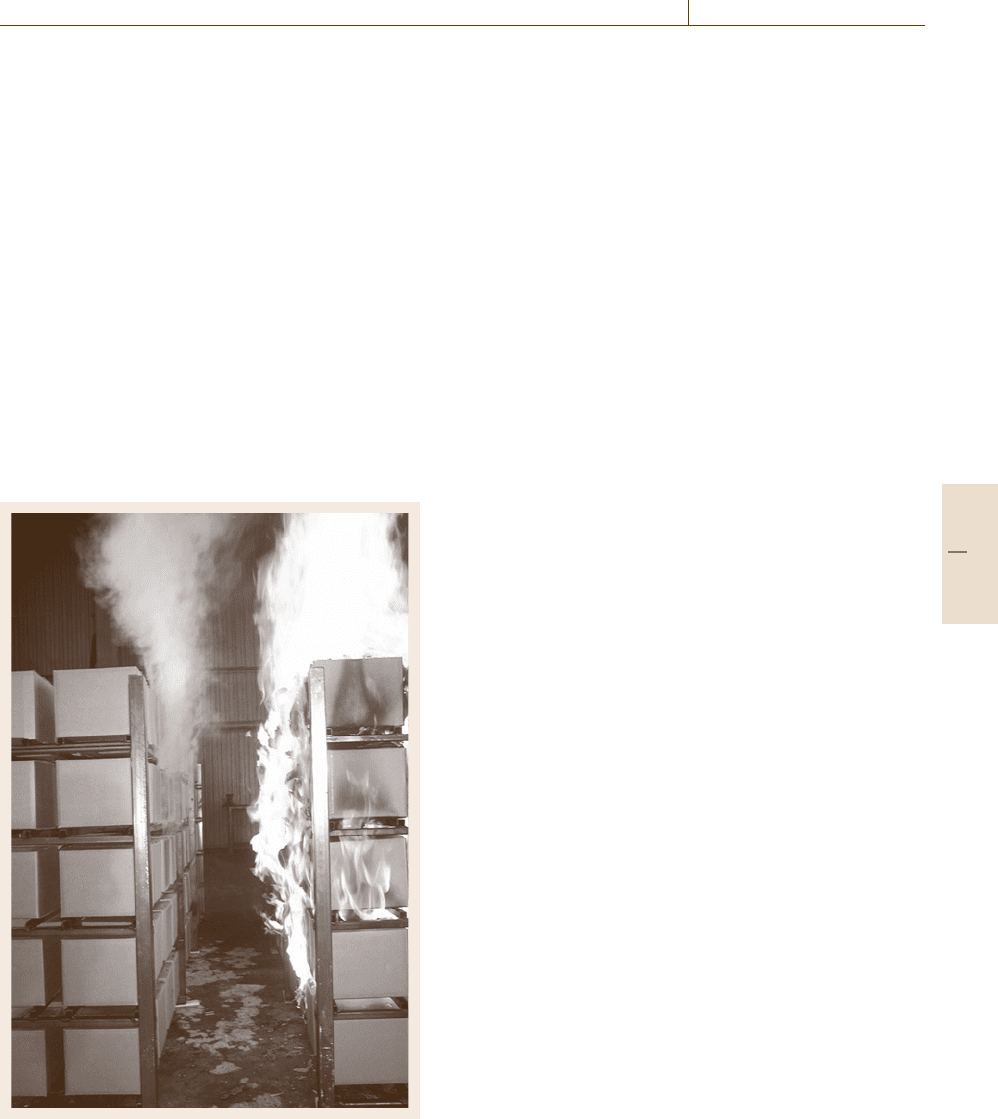
Material–Environment Interactions 15.3 Fire Physics and Chemistry 869
15.2.8 Secondary Emissions
Secondary emissions are a special case of emissions.
Measurements have shown that these emissions do
not occur from the beginning of the test. They are
sometimes formed during testing, as was shown for
emissions from a flooring adhesive [15.103]. At the be-
ginning of the test only typical VOC emissions (mainly
solvents) were detected. After more than 28 d, when
a test is normally broken off, increasing concentrations
of aldehydes and organic acids were already observed
(Fig. 15.28). It is supposed that these are secondary
products of autoxidation processes of unsaturated oils
in the material or on the material’s surface.
15.3 Fire Physics and Chemistry
Fire may be defined as an uncontrolled process of
combustion generating heat, smoke and toxic. It is es-
sentially of fuel available for gas phase combustion that
controls the fire intensity. In fires it is the heat transfer
from flames that heats liquid or solid fuels and thereby
generating gaseous fumes which reacts with the oxygen
in the air. This feedback process make fires an in general
instable process which may either grow or go out.
Fig. 15.29 Ignition of the left side cardboard boxes occurs
when the combustible volatiles are leaving the surface at
a sufficient rate (courtesy of SP)
Fires cause a lot of damage to the society in form of
deaths and injuries as well as economical losses. In Eu-
rope, North America, Australia and Japan the national
losses of lives in fires is between 0.7and2.0 persons
per 100 000 each year and lot more get injured. The di-
rect economical losses are in the order of 0.1–0.3% of
the GDP per year [15.106]. The cost of fire protection
of buildings amounts to as much as 2.5–5% of the total
cost of building and construction.
Designers and product developers strive at minimiz-
ing weight and material consumption by using materials
with low densities and making products for the same
purpose smaller and smaller. As will be explained below
both low density and small thicknesses make materials
prone to ignite and burn faster, it is important that the
issue of fire properties is considered already in an early
stage when developing new materials and products.
It is obvious that fire is an important aspect of the
materials–environment interactions treated in this chap-
ter, which may detrimentally influence the performance
of materials, products and technical systems.
In the following – based on a brief review of the fun-
damentals of fire physics and chemistry – methods and
techniques to characterize the fire behaviour of mater-
ials are compiled.
In addition to the methods for fire testing presented
in this chapter, methods to characterize the general ther-
mal properties of materials are compiled in Chap. 8 on
thermal properties.
15.3.1 Ignition
A mixture of air and a gaseous fuel may ignite and
burn if the concentration ratio of the fuel and the air
is within the upper and lower combustion limits. For
instance, the lower flammable limit of methane in air
at normal temperature and pressure is 5% by volume,
and the upper limit is 15% by volume. As a matter of
fact, for most simple hydrocarbons, the lower and upper
flammable limits in air correspond to an equivalence ra-
Part D 15.3

870 Part D Materials Performance Testing
Table 15.10 Critical temperatures of some liquids (after Quintiere [15.107])
Liquid Formula Flash point (K) Boiling point (K) Autoignition point (K)
Propane C
3
H
8
169 231 723
Gasoline Mixture ≈ 228 ≈306 ≈644
Methanol CH
3
OH 285 337 658
Ethanol C
2
H
5
OH 286 351 636
Kerosene ≈C
14
H
30
≈322 ≈505 ≈ 533
tio of approximately 0.5 and 3, respectively. For further
information about ignition reference [15.106].
Gas mixtures can be ignited either by piloted igni-
tion or by autoignition. Piloted ignition occurs when
a local source of heat or energy is introduced, while
autoignition may occur momentarily for the entire vol-
ume, normally at much higher temperatures than piloted
ignition.
A liquid or solid may start to burn when combustible
volatiles are leaving the surface at a sufficient rate to
form a combustible concentration. Piloted ignition oc-
curs when the concentration of combustible fumes near
a pilot (e.g. a small flame or a spark igniter) reaches the
lower flammable limit.
The rate of evaporation for a liquid is controlled by
the liquid temperature. Therefore liquids will at cer-
tain conditions reach the lower limit concentration at
a given temperature called the flash point depending
on the ease of evaporation. Table 15.10 gives the flash
point temperatures, boiling temperatures and autoigni-
tion temperatures for some liquid fuels.
Time to Ignition
Most common combustible solids ignite by piloted
ignition when the surface reaches a temperature of
250–450
◦
C. The autoignition temperature exceeds nor-
mally 500
◦
C, see Table 15.10 for some liquids and
Table 15.11 for some plastics.
The time it takes the surface of a material (solid or
liquid) to reach a critical temperature like the ignition
temperature when heated depends on the dimensions
and the thermal properties of the material. Two typical
Table 15.11 Ignition temperatures of some plastics, grouped
by category (after Babrauskas [15.106])
Category of solid Ignition temperature (
◦
C)
Piloted Auto
Thermoplastics 369 ±73 457±63
Thermosetting plastics 441±100 514 ±92
Elastomers 318 ±42 353±56
Halogenated plastics 382±79 469±79
cases can be identified, thin solids and thermally thick
solids approximated as semi-infinite solids.
For thin solids, less than about 2 mm, the tempera-
ture is assumed uniform and the thickness is decisive for
the ignition time. Then when assuming a constant total
heat flux
˙
q
tot
(by radiation and convection) to a body
surface and constant material properties, the tempera-
ture rise is proportional to the time and the heat flux
over the parameter group ρcd
T
s
−T
i
=
˙
q
tot
t
ρcd
, (15.5)
where T
s
is the exposed body surface temperature, T
i
the
initial temperature, t time, ρ density, c specific heat ca-
pacity and d thickness. That means that time to ignition
is directly proportional to the density and the thickness
of a thermally thin material, i. e. the surface weight.
When a thin solid is surrounded by air at ambient
temperature and heat by radiation
˙
q
tot
in (15.5)maybe
replaced by incident radiation
˙
q
r
. This yield in prac-
tice just slight underestimations of time to ignition due
to the disregard of cooling by convection and emitted
radiation at elevate surface temperatures.
A similar expression as given by (15.5) can be de-
rived for thermally thick solids, i. e. the thickness is
larger than 2
√
at, where t is time and a is thermal dif-
fusivity, and where in turn a = k/(cρ), where k is the
thermal conductivity. Then for a constant net heat flux
˙
q
tot
and constant thermal properties, the surface temper-
ature rise can ideally be calculated as
T
s
−T
i
=
2
˙
q
tot
√
t
√
π
√
kρc
. (15.6)
The above expression indicates that the rate of sur-
face temperature rise and thereby the time to ignition
is proportional to the product of the heat conductiv-
ity k, the specific heat capacity c and the density ρ.
The grouped property
√
kρc is designated the thermal
inertia of the material.
In this case the influence by convection and emitted
radiation from the exposed surface when the tempera-
Part D 15.3
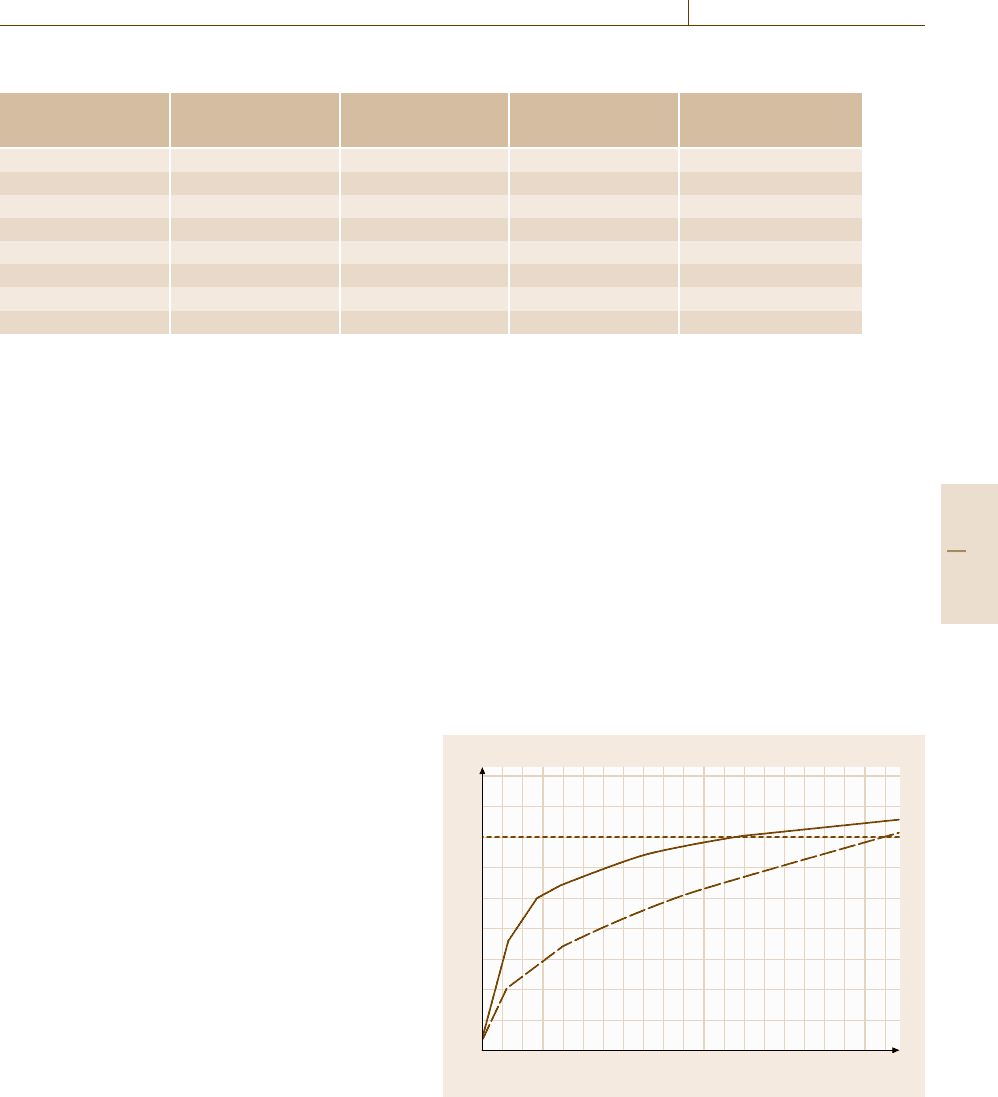
Material–Environment Interactions 15.3 Fire Physics and Chemistry 871
Table 15.12 Example of material thermal properties at room temperature (after Quintiere [15.107])
Material Density Conductivity Specific heat capacity Thermal inertia
(kg/m
3
) (W/(m K)) (J/(kg K)) (Ws
1/2
/(m
2
K))
Polyurethane foam 20 0.03 1400 29
Fiber insulating board 100 0.04 2000 89
Wood, pine 500 0.14 2800 440
Wood, oak 700 0.17 2800 580
Gypsum plaster 1400 0.5 840 770
Concrete 2300 1.7 900 1900
Steel (mild) 7850 46 460 12900
Copper 8930 390 390 36900
ture rises must be considered. Thus
˙
q
tot
=ε
˙
q
r
−σ T
4
s
+h(T
g
−T
s
) , (15.7)
where ε is the surface emissivity and absorptivity
coefficient, σ the Stefan–Boltzmann constant, h the
convection heat transfer coefficient, and T
g
the ambi-
ent gas temperature. Now the net heat flux
˙
q
tot
is not
constant anymore as it depends of the surface tempera-
ture T
s
. A numerical integration is therefore needed to
calculate the development of T
s
and thereby the time to
reach the ignition temperature.
Given the incident radiation is
˙
q
r
and the ambi-
ent gas temperature equal to the initial temperature are
constant, a constant
˙
q
tot
can, however, be obtained for
calculating the time to reach ignition temperature ex-
plicitly from (15.6). Then heat transfer at the surface is
approximated as
˙
q
tot
=ε
˙
q
r
−
˙
q
cr
, (15.8)
where
˙
q
cr
is the critical flux at ignition i. e. the equilib-
rium heat flux when the surface has reached the ignition
temperature T
ig
. It may be identified from (15.6)as
˙
q
cr
=εσ T
4
ig
+h(T
ig
−T
g
) . (15.9)
This approximation is a constant upper limit of the
magnitude of the cooling term
˙
q
cr
before ignition and
leads to overestimates of the times to ignition. For fur-
ther information on alternative approximative solutions
see [15.106].
As an example the time to ignition of a surface
of thick wood suddenly exposed to an incident radia-
tion of 25 kW/m
2
is estimated. The wood is initially
at room temperature and surrounded by air at the same
temperature, 20
◦
C. The wood surface emissivity ε is as-
sumed equal unity, convection heat transfer coefficient
h = 12 W/m
2
K, the other thermal properties accord-
ingtoTable15.12 for pine and the ignition temperature
350
◦
C. Calculated surface temperature development is
shown in Fig. 15.30. The full line shows the temperature
when applying the heat flux according to (15.7), while
the dashed line is obtained when assuming the heat flux
constant with time according to (15.8)and(15.9). From
Fig. 15.30 it can be noted that the ignition time is 65 s
according to the full line while the approximative the-
ory yields 100 s. The latter value can also be calculated
by inserting (15.8)and(15.9)into(15.6) and solve for
the time t when the surface temperature equals the igni-
tion temperature. (A general observation by the author
is that much better agreements are generally obtained by
the simplified approach if the critical heat flux in (15.8)
is reduced by 30%.)
Temperature (°C)
0 20 40 60 80 100
Time (s)
450
400
350
300
250
200
150
0
100
50
Fig. 15.30 Calculated temperature development of a wood surface
exposed an incident radiation of 25 kW/m
2
.Thefull line indicates
the temperature development when applying (15.7)andthedashed
line when approximating the heat according to (15.8,15.9)
Part D 15.3

872 Part D Materials Performance Testing
Anyhow, the estimated of times to ignition as given
above are very crude and based on the assumption of
homogeneous materials with constant material proper-
ties, not varying with temperature or time. The formulas
are, however, very useful for the intuitively understand-
ing of which material properties govern the ease of
ignition.
The thermal inertia varies over a very large range
for common materials. It depends on the product of
density and conductivity, and as conductivity in turn
increases with increasing density. Insulating mater-
ials have low conductivities k (by definition) and low
densities ρ. Therefore the influence of a change in
density has a considerable influence on products fire
behaviour. The specific heat capacity on the other
hand depends on the chemical composition of the
material and does not vary much between common
materials except for wood which has a relatively high
specific heat capacity. Table 15.12 shows how the
thermal inertia increases considerably with density
for various combustible and noncombustible materials.
Note for instance that the thermal inertia of an ef-
ficient insulating material like polyurethane foam is
less than a hundredth of the corresponding value of
wood.
As an example a low density wood fiber board
may have a density of 100 kg/m
3
and a conductiv-
ity of 0.04 W/(m K), while a high density wood/fiber
board have a density of 700 kg/m
3
and a conductivity of
0.15 W/(m K). As such boards can be assumed to have
about the same specific heat capacity, it can be calcu-
lated that the thermal inertia of the high density fiber
board is more than 25 times higher of that of the low
density board. The low density fiber board can there-
fore ideally be estimated to ignite 25 times faster than
the high density fiber board when exposed to the same
constant heating conditions.
Thickness and thermal inertia have also a decisive
influence on flame spread properties of a material or
product. Flame spread can be seen as a continuous ig-
nition process and is therefore governed by the same
thermal material properties as ignition. Thus the fire
hazard of a material or a product can as a rule of thumb
be estimated based on its density as this property gov-
erns how easily the temperature of its surface can be
raised to the ignition temperature. Table 15.12 gives
the thermal properties of some solid materials. These
values are approximative and indicative and may vary
depending on material quality as well as on measuring
techniques.
Spontaneous Ignition
Self-heating leading to spontaneous ignition (com-
monly used interchangeable with spontaneous combus-
tion) can take place in porous materials or in bulks of
granulate solids [15.106]. It involves exothermal (heat
generating) processes which raises the temperature of
the material. Whether the self-heating process leads to
thermal runaway and spontaneous ignition of the mater-
ial or not, is a competition between heat generation and
heat dissipation.
The most common heat generating process is the
oxidation of organic materials in the solid phase and
oxygen in the gas phase. Therefore porous materials are
more susceptible to self-heating than solid materials as
oxygen can diffuse through the material and reach sur-
faces with combustible substances in the interior of the
material. A classical example of spontaneous ignition
is a rag with absorbed vegetarian oil. Unsaturated fatty
acids in the oil are readily oxidised, and with the large
surface area and poor heat dissipation of the rag, the
temperature rise is fast and leads commonly to ignition.
The problem of self-heating frequently arises in
storages of e.g. agricultural products, coal, wood fuels
and municipal waste. Another example is self-heating of
fiberboards in storages after production [15.108]. Stor-
ages of wood chips or pellets are examples of fuels that
commonly self-heat and ignite.
In storage of fuels like wood pellets, biological reac-
tions dominate at temperatures below 100
◦
C, when the
temperature has reached that level, the rate of chemical
oxidation increases and the chemical reactions could
further increase the temperature. The content of mois-
ture is of importance for the self-heating process as it is
necessary for the growth of biological organisms. Gen-
erally, wood fuel containing less than 20% moisture
does not self-heat [15.109]. Further, vaporization and
condensation of water in the bulk transport heat within
the material. The moisture content of the material addi-
tionally influences the heat conduction properties. The
Winds could further augment heat generating reactions
by increasing the availability of oxygen.
Glowing and Smouldering Ignition
When a surface of a combustible solid is exposed to
intense heat, it is changed either by melting or char-
ring and it liberates gaseous products. The surface of
a charring material may obtain very high temperatures
and undergo rapid oxidation, which may be described as
glowing ignition. When glowing in ambient air the tem-
perature is typically in excess of 1000
◦
C. Flaming may
Part D 15.3

Material–Environment Interactions 15.3 Fire Physics and Chemistry 873
also occur either before or after the glowing ignition of
the surface. Wood and fabrics are examples of products
which may ignite first by glowing at the surface and then
burn by flaming [15.106].
Smouldering can be defined as a propagating, self
sustained exothermic reaction wave deriving its heat
from oxidation of a solid fuel. It is a relatively slow
combustion process controlled by the rate of air en-
tering the combustion zone. The smouldering can only
sustain if the material is insulating so that the com-
bustion zone does not loose too much heat and high
temperatures can be maintained. Smouldering is only
common with porous or granular materials that can char.
Materials which are known to smoulder under certain
circumstances include [15.106]
1. wood and cellulosic products in finely divided form,
2. paper,
3. leather,
4. cotton,
5. forest duff, peat and organic soil,
6. latex foam,
7. some types of polyurethane, polyisocyanurate and
phenol formaldehyde foams.
Smouldering may also occur in insulation products
of mineral wool containing high levels of binders as
well as in cellulose loose-fill insulations.
A smouldering fire may break out into flaming,
when the combustion zone reaches for example a wood
surface or when for some reason more oxygen becomes
available. As smouldering fires are very slow they may
last very long and may reach flaming conditions not
until very long times, could in some cases be several
months.
15.3.2 Combustion
A burning candle may serve as a general illustrator of
burning processes. Due to heating from the flame, fuel
evaporates from the wick and is transported by diffusion
towards the surrounding air/oxygen. The combustion
takes place at the flame, which emit light. Hot com-
bustion products are transported upwards as they are
lighter than the cool ambient air. Inside the flame enve-
lope there are fuel vapours and no oxygen and outside it
is vice versa, there is no fuel and ambient concentrations
of oxygen. A candle flame is an example of a laminar
diffusion flame governed by molecular diffusion.
Flames may be categorized as diffusion flames or
premixed flames. In diffusion flames fuel gas and oxy-
gen are transported into a reaction zone and mixed due
to concentration differences. In laminar flames the dif-
fusion is by molecular diffusion. In flames larger than
about 30 cm the laminar flow breaks up into eddies and
we get a turbulent diffusion flame. Although laminar
flames may be important in the ignition phase of a fire,
the turbulent diffusion flames are the most significant in
real fires.
Burning Rate
Burning rate is defined as the mass loss of solid or liquid
fuel consumed by combustion per unit time. A general
formula the mass burning rate may be written as
˙
m
=
˙
q
L
,
where
˙
q is the net heat flux to the fuel surface and L
the heat of gasification. The latter is a material property.
Typical values of L are given in Table 15.13.
When burning the fuel surface is heated by radiation
and convection by nearby flames and hot gases. Heating
by radiation may also come from other sources like re-
mote flames, layers of combustion gases or hot surfaces.
The temperature of the surface of thermoplastics and
liquids will in principle be at the boiling point. For char-
ring materials like wood and thermosetting plastics an
insulating char layer will form, which will hamper the
heat flux to the surface and thereby reduce the burning
rate.
The heat release rate (HRR) or energy release is the
most important quantity for characterizing a fire. It rep-
Table 15.13 Values of heat of gasification and effective
heat of combustion (after Quintiere [15.107])
Fuel L (MJ/kg) ΔH
c
(MJ/kg)
Liquids
Gasoline 0.33 43.7
Heptane 0.50 43.2
Kerosene 0.67 43.2
Ethanol 1.00 26.8
Methanol 1.23 19.8
Thermoplastics
Polyethylene 1.8–3.6 43.3
Polypropylene 2.0–3.1 43.3
Polymethyl metha- 1.6–2.8 24.9
crylate (PMMA)
Nylon 6/6 2.4–3.8 29.6
Polystyrene foam 1.3–1.9 39.8
Char formers
Polyvinylchloride (PVC) 1.7–2.5 16.4
Woods 4.0–6.5 13.0–15.0
Part D 15.3

874 Part D Materials Performance Testing
Table 15.14 Yields of carbon monoxide CO Y
CO
and mass optical density D
m
depending on ventilation (after Quin-
tiere [15.107])
Overventilated or Underventilated or
fuel lean conditions fuel rich conditions
Fuel Y
CO
(kg/kg) D
m
(m
2
/kg) Y
CO
(kg/kg)
Propane 0.005 160 0.23
Heptane 0.01 190 NA
Wood 0.004 37 0.14
Polymethyl methacrylate (PMMA) 0.01 109 0.19
Polystyrene 0.06 340 NA
Polyurethane flexible foam 0.03 330 NA
Polyvinylchloride (PVC) 0.06 400 0.36
resents the size of the fire and relates directly to flame
height and production rates of combustion products like
smoke and toxic gas species.
The heat release rate
˙
q is the product of the burning
rate
˙
m
and ΔH
c
˙
q =
˙
m
AΔH
c
where A is the fuel area involved. The effective heat of
combustion is a material property (Table 15.13).
Combustion Products
The nature of the combustion products developed in
a fire depends on the fuel as well as on the entire fire
process. The chemical reactions occurring in the de-
composition of the fuel and in the reaction with oxygen
depend on temperature, gas flow conditions, ratio be-
tween fuel and air available for the combustion process
etc. If more air is available than needed for a complete
burning process the condition is assumed to be over ven-
tilated or process fuel lean. For less air, the process is
termed underventilated or fuel rich. If the fuel to air
ratio perfectly match the burning process is stoichio-
metric. A parameter that quantitatively represents over-
and underventilation in fires is the equivalence ratio φ
defined as
Φ =
(
mass of fuel/mass of air
)
(
mass of fuel/mass of air
)
stoich
.
Thus for Φ<1 the fire is fuel lean and for Φ>1
fuel rich.
In a similar way as the heat of combustion gives the
energy release, yields give the mass production rate of
combustion product species per unit mass of fuel. As
an example the rate of CO mass produced
˙
m
CO
can be
calculated as
˙
m
CO
=
˙
mY
CO
where
˙
m is the rate of burning and Y
CO
the yield of CO.
The yields of various species are reasonably constant as
the fire conditions are well ventilated φ<1. Under fuel
rich conditions φ>1, however, the yields changes and
the production rates increases for many toxic species.
Yields of carbon monoxide are given in Table 15.14.
Light is attenuated by smoke mainly due to soot par-
ticles. Smoke has in many cases a decisive influence on
the ability to escape a fire. Therefore the propensity of
a material to release smoke is an essential fire property
of a material. The reduced intensity of light I can be
measured with a lamp and photocell at a distance l away
and be expressed as
I = I
0
e
−κl
,
where I
0
is the original intensity. The parameter κ is the
extinction coefficient with the dimension one over unit
length (m
−1
). For a given mass of fuel burnt material m
in a closed volume V the extinction coefficient κ may
be obtained as
κ =
mD
m
V
,
where D
m
is the mass optical density with the di-
mensions mass over area (kg/m
2
), which is a material
property for overventilated conditions. Values for some
common products are given in Table 15.14.
Toxic Products
Organic fuels like wood and polymers contain mainly
carbon and hydrogen. Thus when burning with enough
oxygen available (fuel lean conditions) the combustion
process may be completed and mainly carbon dioxide
and water are generated. However, under fuel rich con-
ditions or when the combustion process is interrupted
due to cooling (quenching), the combustion process is
incomplete and several chemical species are generated
Part D 15.3

Material–Environment Interactions 15.3 Fire Physics and Chemistry 875
which may be toxic. The most important is carbon
monoxide which is the cause of most fire casualties.
Products containing nitrogen like polyurethane may
generate toxics substances like hydrocyanic acid HCN
and isocyanates which have a very high toxic potency.
Soot particles may also constitute a toxicological
threat as they can transport toxic species from fires ad-
hered to their surfaces deep into the lungs.
Corrosive Products
Some products like polyvinylchloride PVC generate
acid gases like HCl when burning, which is irritating for
the eyes and air passages although not necessarily fatal
during inhalation. This may hamper the evacuation of
a building on fire. In addition HCl dissolves in water
droplets and forms hydrochloric acid, which is highly
corrosive and may deposit on metal surfaces and cause
damages. Such corrosive damages may show up long
after a fire and cause a great threat to electronic equip-
ment which in many cases must be discarded after a fire
although not being directly exposed flames or hot gases
and seemingly being undamaged.
Flame Retardants
There are numerous chemical compounds used to
inhibit the combustion process in materials, mainly
plastics. Flame retardants can function by intervening
in the combustion process chemically or physically, or
through a combination of both. Common for all flame
retardants is that they interfere early in the combustion
process during the heating phase or the ignition phase.
Physically a flame retardant additive can act as
a barrier by forming a layer of char when exposed to
heat. This layer then protects the underlying material
from heat and thereby from degradation and the en-
suing generation of combustible fumes. Further, these
flame retardants remove the direct connection between
the oxygen in air and the fuel [15.110]. Flame retar-
dants can also act by cooling. In such cases the additive
degrades endothermally, thereby cooling and possibly
diluting the gas mixture of the combustion process, for
example through the production of water vapour. In
certain instances additives can be used that act only
by diluting the material with inert substances such as
fillers. This will typically reduce the heat release from
a certain weight of a material but have little effect on the
ignitibility of the material per se.
Chemically flame retardants can act by accelerat-
ing the initial breakdown of the material, causing the
material to withdraw from or to flow away from the ig-
nition source or by promoting the generation of a char
layer. Other flame retardants may act in the gas phase
through removal of free radicals that are the motor in the
exothermic combustion process. The process is shown
by the formula below
HX +H
•
→H
2
+X
•
HX +HO
•
→H
2
O +X
•
,
where X represents a halogen.
The main families of flame retardants are halo-
genated (i. e., containing chlorine or bromine), phos-
phorous based, nitrogen based, inorganics and others
(including antimony trioxide and nanocomposites).
Many of these systems work either in isolation or to-
gether with some systems exhibiting synergistic effects
when used in combination.
Brominated flame retardants have the highest mar-
ket share in terms of turnover while aluminum hydrox-
ide has the highest market share by weight. A global
growth of approximately 3% has been projected by
the flame retardants industry in the near future with
inorganic flame retardants (e.g. aluminum hydroxide)
having the highest projected growth rate.
Flame retardants have received broad application in
correlation with the ubiquitous use of plastics in our so-
ciety. While certain plastics have unacceptable ignition
and flame spread properties, they also exhibit highly de-
sirable mechanical properties, i. e., their ability to be
formed into a myriad of shapes and applications. Thus,
the safe application of plastics has at least partially been
dependent on the use of flame retardant additives to
modify undesirable ignition and flame spread proper-
ties.
In recent years environmental concerns about many
of these additives has prompted questions about the suit-
ability of their broad use. Legislation is under way in
Europe and elsewhere to control the use of these chemi-
cals. Research into quantifiable tools to determine the
true environmental impact of the use of flame retar-
dants to obtain a high level of fire safety have, however,
clearly identified the need to consider such issues holis-
tically [15.111].
15.3.3 Fire Temperatures
Temperatures in natural fires depend on actual combus-
tion conditions such as fuel/air ratio and heat losses to
the environment mainly by radiation. Thus the max-
imum temperature of turbulent diffusion flames of
free-burning fires is in the order of 800–1200
◦
C. Fires
in enclosures with limited openings may at the most
reach temperatures in the order of 1200
◦
C.
Part D 15.3
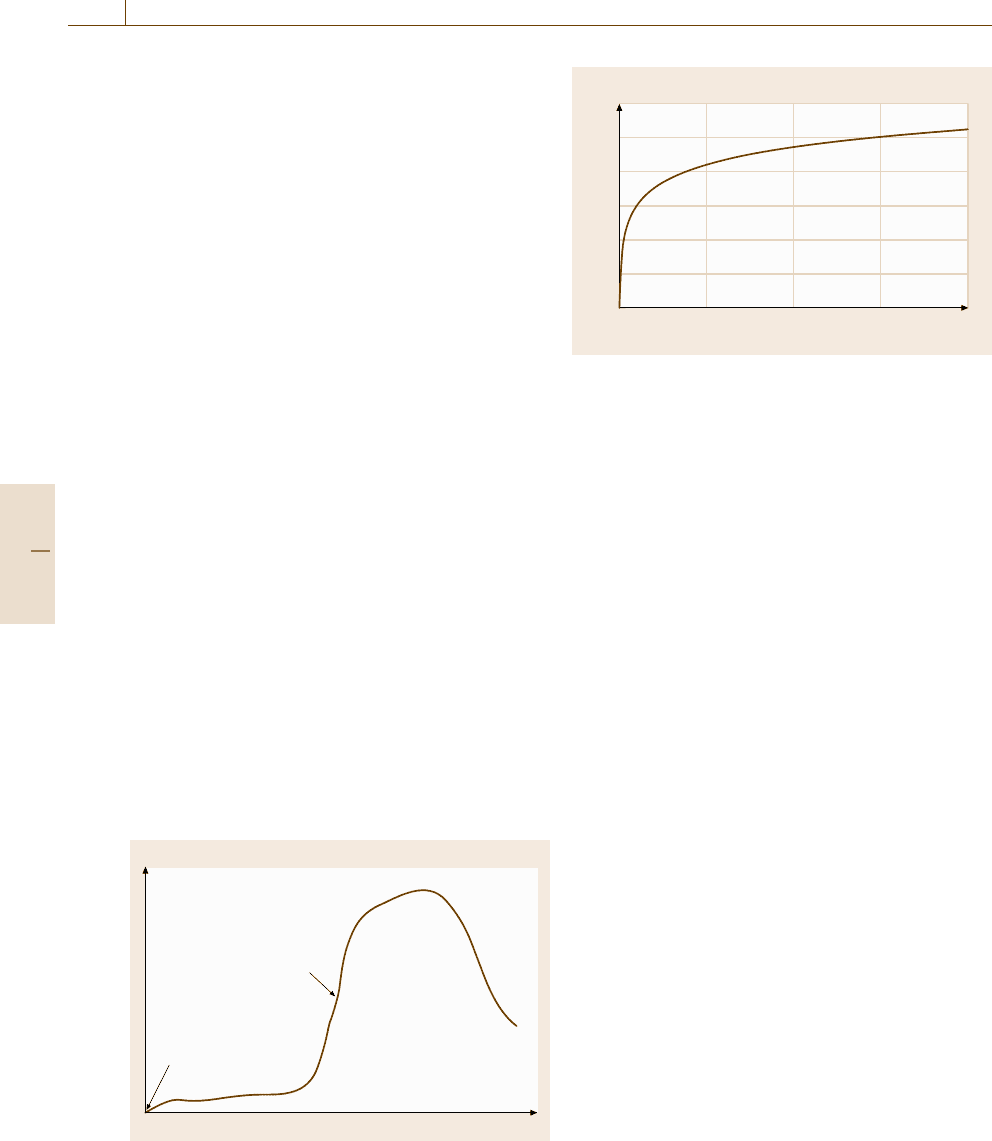
876 Part D Materials Performance Testing
Mechanically ventilated fires may under certain
very favourable conditions for combustion develop ex-
tremely high temperatures. Thus fires in tunnels may
reach temperatures of nearly 1400
◦
C with ordinary fu-
els of cellulosic materials. Temperatures of that order of
magnitude were measured in several tests carried out in
a tunnel in Norway 2003 where fires in trailers loaded
with wood pallets and furniture were simulated. Such
temperature levels expose the surrounding tunnel walls
to devastating thermal loads causing concrete linings to
spall and fall off in pieces. Therefore tunnels linings
must be designed to resist much higher temperatures
than other building structures.
Room Fires
The various stages of a fire in a room or compartment
with limited openings are shown in Fig. 15.31. Initially
the fire is not affected by the surrounding structures. In
this growth stage, which may last from a few minutes to
several hours, the fire intensity is fuel controlled.Asthe
fire intensity increases the temperature rises and more
and more combustible fumes are released. At a certain
stage the fire may start to grow rapidly and flashover.
After that in the post-flashover stage the fire consumes
all available oxygen inside the compartment. It is then
a ventilation controlled or fully developed fire. The
combustion rate at this stage depends on the amount
of oxygen or air that can enter the fire compartment,
i. e. it depends on the size and shape of the compart-
ment openings. At this stage the fire generates a lot of
heat, smoke and toxic gases, and the temperature of the
combustion gases is at least 600
◦
C and rises as the sur-
rounding structures, i. e. walls, floors and ceilings heats
up. Excess combustible fumes will at this stage emerge
Temperature
Ignition
Growth
Flashover
Post-flashover
Decay
Time
Fig. 15.31 General description of the various stages of
a room fire (courtesy of SP)
Temperature (°C)
1200
1000
800
600
400
200
0
0 30 60 90 120
Time (min)
Fig. 15.32 The standard time–temperature curve according
to EN 1363 or ISO 834
outside the compartment openings and burn as flames
shooting out from the openings. Flashover represents
a crucial event in the development of a fire as it goes
from being a local fire in one room or compartment to
a much more severe fire having the potential of rapidly
spreading heat and smoke throughout a building.
Significant building components must be designed
to resist a fully developed fire. Such a fire is then usually
simulated by the so called standard fire curve as shown
in Fig. 15.32. This time–temperature curve is meant to
simulate a typical fire at the post-flashover stage.
Compartments fire developments can be numeri-
cally modelled in three ways [15.112]. The simplest
are the one-zone models where the entire compartment
gas volume is assumed to be at uniform temperature.
Mass flow in and out of the compartment is driven by
buoyancy. Hot fire gases are lighter than the ambient
air and flow out at the top of the openings and are
replaced by cool fresh air further down. The fire tem-
perature development will depend on the thermal inertia
of the surrounding structure and on the size and height
of the openings. Lower thermal inertia (in principle low
density) and large openings implies faster fire growth
higher temperatures. One-zone models are suited only
for fully developed fires. In two-zone models the fire
compartment is divided into an upper hot zone with
fire gases and a lower zone with air at ambient tem-
perature (Fig. 15.33) models are suited for fires before
reaching flashover. More advanced are the so called
CFD (computational fluid dynamics) models where the
compartment is divided to a large number of volume el-
ements. Then arbitrary fire conditions can be analysed
in terms of temperature as well as concentrations of
smoke and (toxic) gas species. CFD models are very
Part D 15.3
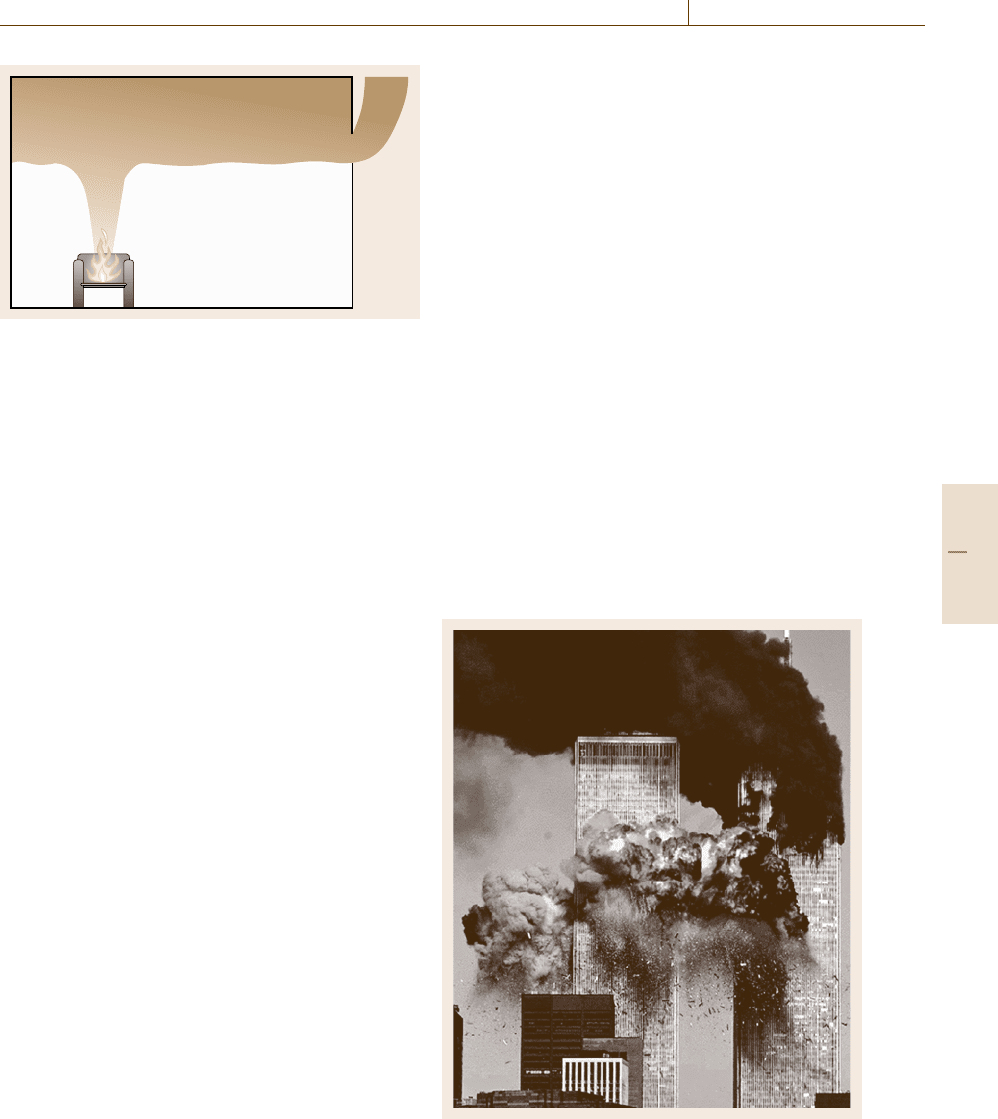
Material–Environment Interactions 15.3 Fire Physics and Chemistry 877
Hot layer
Cold layer
Fig. 15.33 Two-zone model of a room fire with an upper
hot layer and a lower layer at ambient temperature (cour-
tesy of SP)
powerful but require substantial computer capacities
and detailed material property data.
15.3.4 Materials Subject to Fire
Structural Materials
The temperature in structures exposed to fully devel-
oped fires with gas temperatures reaching 800–1200
◦
C
will gradually increase and eventually the structures
may loose their load-bearing capacity as well as their
ability to confine the fire to a limited space. In building
codes fire resistance requirements are usually expressed
in terms of time of a structure to resist a nominal or
standard fire defined for example in the international
standard ISO 834 or the corresponding European stan-
dard EN 1363-1 (Fig. 15.32). In USA the corresponding
standard for determining fire resistance of building
components is ASTM E-119.
Steel starts to lose both strength and stiffness at
about 400 and above 600
◦
C more than half the strength
is lost [15.113]. Therefore structural steel elements must
in most cases be fire insulated by sprayed on com-
pounds, boards, mineral wool or intumescent paint to
keep sufficient load-bearing capacity when exposed to
fire. An example of a steel structure failure due to fire
was the collapse of two World Trade Center towers on
September 11, 2001 after each of them had been hit
by a big passenger airplane. A tremendous impact on
the buildings but they did not collapse until after about
half an hour. The jet fuel had started intense fires and
when the strength and stiffness of the steel structures
had been eroded due high temperatures the structures
failed.
Concrete also looses strength and stiffness at high
temperature [15.114]. This is, however, generally not
a problem as concrete has a high density and specific
heat capacity as well as a low thermal conductivity.
Therefore temperature rises slowly in concrete struc-
tures and even the steel reinforcement bars are in
general well protected. More problematic is the ten-
dency of concrete to spall when exposed to high
temperatures. In particularly high strength concrete
qualities are prone to spall. Spalling is not least a prob-
lem when designing road and railway tunnels where
fire temperatures may be extremely high and where
a collapse of a tunnel lining may have devastating con-
sequences.
Wood looses both strength and stiffness as well at
elevated temperature. It burns and chars gradually at
a rate of about 0.5mm/min when exposed to fire con-
ditions. The char layer protects the wood behind from
being directly exposed to fire conditions and thereby
quickly heated and losing its load-bearing capacity.
Timber structures therefore resist fire rather very well
and can in many cases be used unprotected, see e.g.
Eurocode 5 [15.115]. In many cases structural timber
members like wall studs are protected from direct ex-
posure by fire boards of for example gypsum and can
therefore resist fire for very long periods of time.
Fig. 15.34 The jet fuel started intense fires that caused the
World Trade Center towers to collapse on September 11,
2001
Part D 15.3
